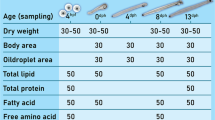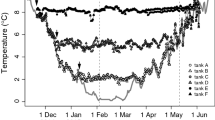Abstract
Atlantic salmon (Salmo salar L.) females (2 SW), maturing for the first time, were reared under one of three temperature regimes (high: 14.3 ± 0.5°C; natural: 10.6 ± 1.0°C; and cold: 6.9 ± 1.0°C) in combination with one of two experimental treatments; an injection of GnRH analogue (GnRHa) contained in biodegradable microspheres, or a sham injection (microspheres only). The six experimental groups were then reared under simulated natural photoperiod for 4 weeks. Blood samples were drawn for analysis of plasma steroid levels and the fish were inspected for ovulation weekly. Batches of stripped eggs were incubated in triplicate incubators in raceways until the eyed stage. Treatment with GnRHa resulted in a substantial advancement and synchronization of ovulation at all temperatures, while exposure to cold water also appeared to advance ovulation slightly. While 75% (warm and cold) to 90% (natural) of GnRHa fish ovulated during the 4-week trial, only 30% of sham-treated females exposed to cold water, and none of the sham-treated fish held at higher temperatures, ovulated during this period. Survival rates of embryos to the eyed-stage were significantly higher for broodstock exposed to cold water. Plasma levels of testosterone (T), 17β-oestradiol (E2), and 17α,20β-dihydroxy-4-pregnen-3-one (17,20βP) were all significantly affected by treatment with GnRHa and, to a lesser extent, temperature. The efficiency of GnRHa in counteracting the negative effects of high temperature on ovulation and the associated changes in circulating sex steroids suggest that temperature inhibition operates at least in part at the brain or pituitary.







Similar content being viewed by others
References
Brown NP, Bromage N, Shields RJ (1995) The effects of spawning temperature on egg viability in the Atlantic halibut (Hippoglossus hippoglossus). In: Goetz FW, Thomas P (eds) Proceedings of the fifth international symposium on the reproductive physiology of fish, The University of Texas at Austin, Austin, Texas, USA, 2–8 July 1995, p 181
Chan STH, Yeung WSB (1986) A new method for the simultaneous determination of androstenedione, testosterone, 11-oxotestosterone and 11-beta-oh-testosterone in fish plasma using combined techniques of celite chromatography and radioimmunoassay. J Steroid Biochem Mol Biol 25:1013–1021
Crim LW, Glebe BD, Scott AP (1986) The influence of LHRH analog on oocyte development and spawning in female Atlantic salmon, Salmo salar. Aquaculture 56:139–149
Crim LW, Sherwood NM, Wilson CE (1988) Sustained hormone release 2: effectiveness of LHRH analog (LHRHa) administration by either single time injection or cholesterol pellet implantation on plasma gonadotropin levels in a bioassay model fish, the juvenile rainbow trout. Aquaculture 74:87–95
Dahle R, Taranger GL, Karlsen Ø, Kjesbu OS, Norberg B (2003) Gonadal development and associated changes in liver size and sexual steroids during the reproductive cycle of captive male and female Atlantic cod (Gadus morhua L). Comp Biochem Physiol A Mol Integr Physiol 136:641–653
Davies B, Bromage N (2002) The effects of fluctuating seasonal and constant water temperatures on the photoperiodic advancement of reproduction in female rainbow trout Oncorhynchus mykiss. Aquaculture 205:183–200
Devlin RH, Nagahama Y (2002) Sex determination and sex differentiation in fish: an overview of genetic, physiological, and environmental influences. Aquaculture 208:191–364
Goren A, Gustafson H, Doering D (1995) Field trials demonstrate the efficacy and commercial benefit of a GnRHa implant to control ovulation and spermiation in salmonids. In: Goetz FW, Thomas P (eds) Proceedings of the fifth international symposium on the reproductive physiology of fish, The University of Texas at Austin, Austin, Texas, USA, 2–8 July 1995, pp 99–101
Hyllner SJ, Norberg B, Haux C (1994) Isolation, partial characterization, induction, and the occurrence in plasma of the major vitelline envelope proteins in the Atlantic halibut (Hippoglossus hippoglossus) during sexual maturation. Can J Fish Aquat Sci 51:1700–1707
King HR, Pankhurst NW (2000) Ovulation of Tasmanian Atlantic salmon maintained at elevated temperatures: implications of climate change for sustainable industry development. In: Norberg B, Kjesbu OS, Taranger GL, Andersson E, Stefansson SO (eds) Proceedings of the 6th international symposium on the reproductive physiology of fish, Bergen, 4–9 July 1999, pp 396–398
King HR, Pankhurst NW (2004a) Effect of maintenance at elevated temperatures on ovulation and luteinizing hormone releasing hormone analogue responsiveness of female Atlantic salmon (Salmo salar) in Tasmania. Aquaculture 233:583–597
King HR, Pankhurst NW (2004b) Effect of short-term temperature reduction on ovulation and LHRHa responsiveness in female Atlantic salmon (Salmo salar) maintained at elevated water temperatures. Aquaculture 238:421–436
King HR, Pankhurst NW, Watts M, Pankhurst PM (2003) Effect of elevated summer temperatures on gonadal steroid production, vitellogenesis and egg quality in female Atlantic salmon. J Fish Biol 63:153–167
Mayer I, Berglund I, Rydevik M, Borg B, Schulz R (1990) Plasma levels of five androgens and 17α-hydroxy-20β-dihydroprogesterone in immature and mature male Baltic salmon (Salmo salar) parr, and the effects of castration and androgen-replacement in mature parr. Can J Zool 68:263–267
Mayer I, Schmitz M, Borg B, Schulz R (1992) Seasonal endocrine changes in male and female arctic charr (Salvelinus alpinus) 1. Plasma-levels of 3 androgens, 17-alpha-hydroxy-20-beta-dihydroprogesterone, and 17-beta-estradiol. Can J Zool 70:37–42
Mylonas CC, Zohar Y (2001a) Endocrine regulation and artificial induction of oocyte maturation and spermiation in basses of the genus Morone. Aquaculture 202:205–220
Mylonas CC, Zohar Y (2001b) Use of GnRHa-delivery systems for the control of reproduction in fish. Rev Fish Biol Fish 10:463–491
Mylonas CC, Tabata Y, Langer R, Zohar Y (1995) Preparation and evaluation of polyanhydride microspheres containing gonadotropin-releasing-hormone (GnRH), for inducing ovulation and spermiation in fish. J Control Release 35:23–34
Mylonas CC, Woods LC, Zohar Y (1997) Cyto-histological examination of post-vitellogenesis and final oocyte maturation in captive-reared striped bass. J Fish Biol 50:34–49
Mylonas CC, Woods LC, Thomas P, Zohar Y (1998) Endocrine profiles of female striped bass (Morone saxatilis) in captivity, during postvitellogenesis and induction of final oocyte maturation via controlled-release GnRHa-delivery systems. Gen Comp Endocrinol 110:276–289
Nagahama Y (1987) Gonadotropin action on gametogenesis and steroidogenesis in teleost gonads. Zool Sci 4:209–222
Nagahama Y (1994) Endocrine regulation of gametogenesis in fish. Int J Dev Biol 38:217–229
Nagahama Y, Yoshikuni M, Yamashita M, Tokumoto T, Katsu Y (1995) Regulation of oocyte growth and maturation in fish. Curr Top Dev Biol 30:103–145
Pankhurst NW, Thomas PM (1998) Maintenance at elevated temperature delays the steroidogenic and ovulatory responsiveness of rainbow trout Oncorhynchus mykiss to luteinizing hormone releasing hormone analogue. Aquaculture 166:163–177
Pankhurst NW, Purser GJ, Van Der Kraak G, Thomas PM, Forteath GNR (1996) Effect of holding temperature on ovulation, egg fertility, plasma levels of reproductive hormones and in vitro ovarian steroidogenesis in the rainbow trout Oncorhynchus mykiss. Aquaculture 146:277–290
Peter RE, Yu KL (1997) Neuroendocrine regulation of ovulation in fishes: basic and applied aspects. Rev Fish Biol Fish 7:173–197
Rodriguez L, Begtashi I, Zanuy S, Carillo M (2000) Development and validation of an enzyme immunoassay for testosterone: effects of photoperiod on plasma testosterone levels and gonadal development in male sea bass (Dicentrachus labrax L.) at puberty. Fish Physiol Biochem 23:141–150
Taranger GL, Hansen T (1993) Ovulation and egg survival following exposure of Atlantic salmon, Salmo salar L., broodstock to different water temperatures. Aquac Fish Manag 24:151–156
Taranger GL, Haux C, Stefansson SO, Bjornsson BT, Walther BT, Hansen T (1998) Abrupt changes in photoperiod affect age at maturity, timing of ovulation and plasma testosterone and oestradiol-17 beta profiles in Atlantic salmon, Salmo salar. Aquaculture 162:85–98
Taranger GL, Haux C, Hansen T, Stefansson SO, Bjornsson BT, Walther BT, Kryvi H (1999) Mechanisms underlying photoperiodic effects on age at sexual maturity in Atlantic salmon, Salmo salar. Aquaculture 177:47–60
Taranger GL, Stefansson SO, Oppedal F, Andersson E, Hansen T, Norberg B (2000) Photoperiod and temperature affect spawning time in Atlantic salmon (Salmo salar L.). In: Norberg B, Kjesbu OS, Taranger GL, Andersson E, Stefansson SO (eds) Proceedings of the 6th international symposium on the reproductive physiology of fish, Bergen, 4–9 July 1999, p 345
Van Der Kraak G, Dye HM, Donaldson EM (1984) Effects of LHRH and Des-Gly10 D-Ala6 Lh-Rh-Ethylamide on plasma sex steroid profiles in adult female Coho salmon (Oncorhynchus kisutch). Gen Comp Endocrinol 55:36–45
Vikingstad E, Andersson E, Norberg B, Mayer I, Stefansson SO, Taranger GL (2005a) Effects of temperature during the final stages of sexual maturation on the reproductive performance of Atlantic salmon (Salmo salar L.). PhD Thesis Paper III
Vikingstad E, Andersson E, Norberg B, Mayer I, Klenke U, Zohar Y, Stefansson SO, Taranger GL (2005b) Effects of temperature and GnRHa treatment on the final stages of sexual maturation in Atlantic salmon (Salmo salar) II: males. Ph.D. Thesis, University of Bergen, Norway, Paper V
Watts M, Pankhurst NW, King HR (2004) Maintenance o Administration of Atlantic salmon (Salmo salar) at elevated temperature inhibits cytochrome P450 aromatase activity in isolated ovarian follicles. Gen Comp Endocrinol 135:381–390
Acknowledgments
The authors would like to thank the staff at the Institute of Marine Research, Matre, for their valuable assistance in the preparation and execution of the experimental work and subsequent analyses. Ms. Sissel Waage Kalvenes and Ms. Svanhild Lohne Gokstad at the Institute of Marine Research, Austevoll, are acknowledged for skilful assistance with steroid ELISAs. This study was financed by the Norwegian Research Council grant no. 133937/122.
Author information
Authors and Affiliations
Corresponding author
Rights and permissions
About this article
Cite this article
Vikingstad, E., Andersson, E., Norberg, B. et al. The combined effects of temperature and GnRHa treatment on the final stages of sexual maturation in Atlantic salmon (Salmo salar L.) females. Fish Physiol Biochem 34, 289–298 (2008). https://doi.org/10.1007/s10695-007-9187-9
Received:
Accepted:
Published:
Issue Date:
DOI: https://doi.org/10.1007/s10695-007-9187-9




